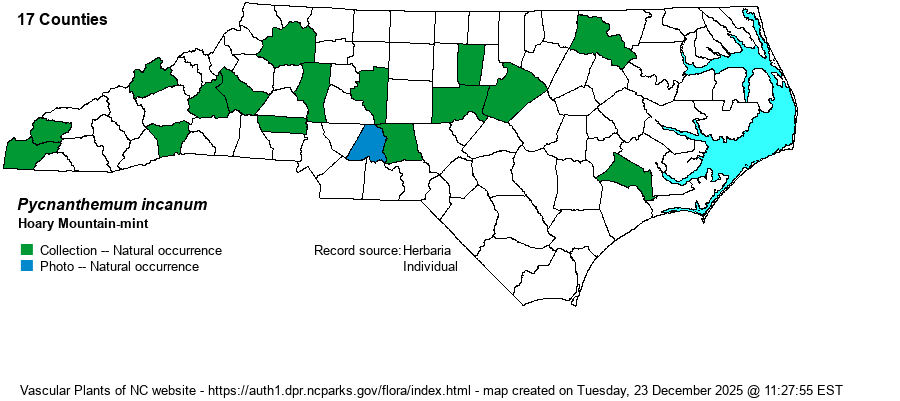| Author | (L.) Michaux | |
| Distribution | The map below is populated only with specimens from the SERNEC database listed in NCU (University of North Carolina herbarium). The website editors have confidence that these specimens have been checked against several other very similar species -- especially P. loomisii and P. pycnanthemoides, which have often been "dumped" into P. incanum, especially based on RAB (1968). Obviously, there are a large number of specimens in other herbaria labelled as "Pycnanthemum incanum", many of which must certainly be correct, but for the present time, this website chooses to be conservative and follow Weakley (2018) and the specimens at NCU for the maps and distribution and abundance information. Based on the scatter of county records, and Weakley's map, the species probably occurs over all of the Mountains and Piedmont, but is very scarce in the Coastal Plain. A specimen from Hertford County proves to be P. pycnanthemoides.
This is a somewhat Northern species, ranging from VT and southern OH, south to FL and AL. This range encompasses two varieties found in NC. | |
| Abundance | Weakley's (2024) map shows the nominate variety as "rare" for all three provinces; and the other variety (var. puberulum) also as "rare" in all three provinces. Collectively, this suggests that the species is best called rare to possibly uncommon statewide. The NCNHP's State Rank of S4 is likely based on the RAB (1968) range map. Considering the Weakley maps and the spread of specimens on the map, the website editors feel that the species is possibly correct at S4, but with just 16 counties represented by NCU specimens thus far, a State Rank of S3? seems best, for now. It appears to be less common than is P. pycnanthemoides, which is here given a State Rank of S5, and also P. loomisii, which is here given a rank of S4? | |
| Habitat | This habitats for this species are apparently very similar to those of P. pycnanthemoides and P. loomisii -- open, upland woods, wooded borders, and other dry and upland places, in partial shade. | |
| Phenology | Blooms from late June to August, and fruits from September to October. | |
| Identification | This species is a typical mountain-mint, being about 3 feet tall, freely branched in the upper portions of the stem, and with numerous pairs of opposite leaves. The leaves tend to be ovate, nearly sessile, toothed along the margin, and about 2-3 inches long and half as wide. These species have rather flat-topped heads of about 1-2 inches wide at the ends of each branch, subtended by whitened bracts, with the flowers being very small and generally white with some purple spots on the lower lip. There are many such heads in bloom over the plant, often dozens of them. Separation of this species from others is technical and involves closely examining the calyx or the seeds. Use Weakley (2018) or Wofford (1989) to key out the species, as well as the two varieties (to add to your confusion). Somewhat helpful is Gleason's (1952) comment for P. pycnanthemoides: "Closely resembling P. incanum in habit, foliage, and pubescence, although with a general tendency toward more numerous spreading hairs on the bracts and calyx lobes." He also mentions the difference in flower color, with that species having pink to purple corollas, versus white spotted with purple in P. incanum. This species should be encountered from time to time by biologists, probably less so than the very similar P. pycnanthemoides, but you will likely need to collect a branch/twig and key it out to be sure. | |
| Taxonomic Comments | There are two varieties listed in Weakley (2018). The nominate var. incanum is the more northerly of the two, ranging south only to NC, whereas var. puberulum ranges from NC to FL, obviously the southern form.
| |
| Other Common Name(s) | None | |
| State Rank | S4 [S3?] | |
| Global Rank | G5 | |
| State Status | | |
| US Status | | |
| USACE-agcp | | |
| USACE-emp | | |

